Input interpretation

diatrizoate
Chemical names and formulas
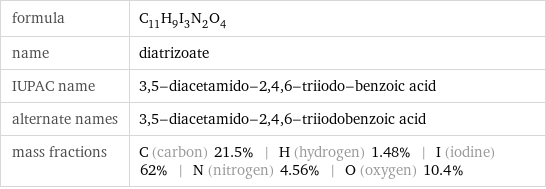
formula | C_11H_9I_3N_2O_4 name | diatrizoate IUPAC name | 3, 5-diacetamido-2, 4, 6-triiodo-benzoic acid alternate names | 3, 5-diacetamido-2, 4, 6-triiodobenzoic acid mass fractions | C (carbon) 21.5% | H (hydrogen) 1.48% | I (iodine) 62% | N (nitrogen) 4.56% | O (oxygen) 10.4%
Lewis structure
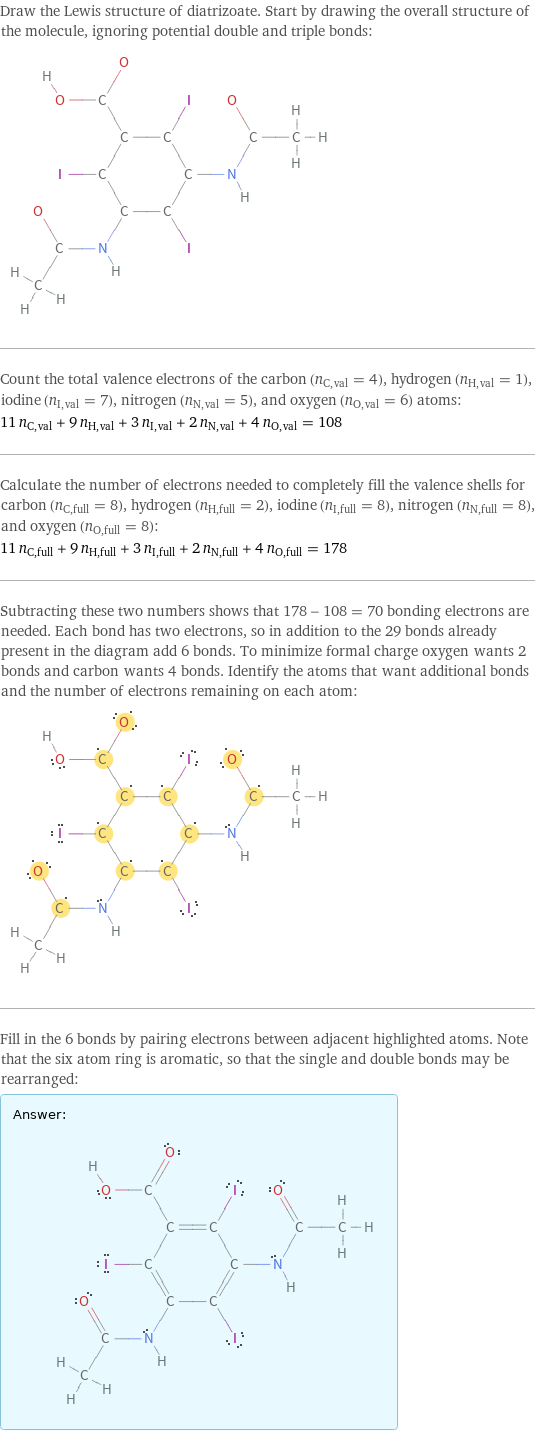
Draw the Lewis structure of diatrizoate. Start by drawing the overall structure of the molecule, ignoring potential double and triple bonds: Count the total valence electrons of the carbon (n_C, val = 4), hydrogen (n_H, val = 1), iodine (n_I, val = 7), nitrogen (n_N, val = 5), and oxygen (n_O, val = 6) atoms: 11 n_C, val + 9 n_H, val + 3 n_I, val + 2 n_N, val + 4 n_O, val = 108 Calculate the number of electrons needed to completely fill the valence shells for carbon (n_C, full = 8), hydrogen (n_H, full = 2), iodine (n_I, full = 8), nitrogen (n_N, full = 8), and oxygen (n_O, full = 8): 11 n_C, full + 9 n_H, full + 3 n_I, full + 2 n_N, full + 4 n_O, full = 178 Subtracting these two numbers shows that 178 - 108 = 70 bonding electrons are needed. Each bond has two electrons, so in addition to the 29 bonds already present in the diagram add 6 bonds. To minimize formal charge oxygen wants 2 bonds and carbon wants 4 bonds. Identify the atoms that want additional bonds and the number of electrons remaining on each atom: Fill in the 6 bonds by pairing electrons between adjacent highlighted atoms. Note that the six atom ring is aromatic, so that the single and double bonds may be rearranged: Answer: | |
3D structure
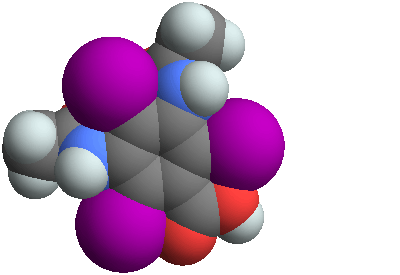
3D structure
Basic properties
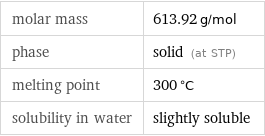
molar mass | 613.92 g/mol phase | solid (at STP) melting point | 300 °C solubility in water | slightly soluble
Units

Hydrophobicity and permeability properties

experimental LogP hydrophobicity | 3.3 predicted LogP hydrophobicity | 2.27 predicted LogS | -3.76
Basic drug properties

approval status | approved | small molecule drug categories | contrast media dosage forms | intravenous: liquid | oral: powder | intravenous: solution | urethral: solution

brand names | angiovist 282 | cardiografin | conray 35 | diat | gastrografin | hypaque | iothalamate | odiston | reno-dip | renografin 76 | triombrin | triombrine | urotrast | urovison | urovist cysto | urovist cysto pediatric | urovist sodium 300 | vascoray
Chemical identifiers
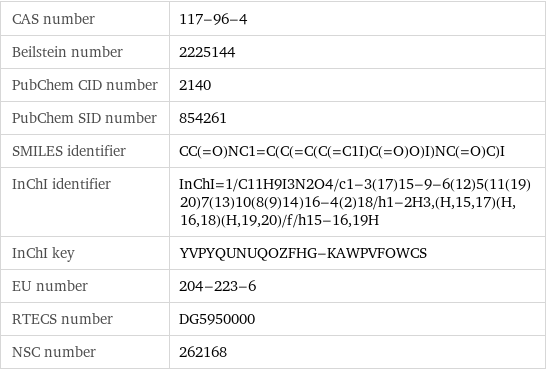
CAS number | 117-96-4 Beilstein number | 2225144 PubChem CID number | 2140 PubChem SID number | 854261 SMILES identifier | CC(=O)NC1=C(C(=C(C(=C1I)C(=O)O)I)NC(=O)C)I InChI identifier | InChI=1/C11H9I3N2O4/c1-3(17)15-9-6(12)5(11(19)20)7(13)10(8(9)14)16-4(2)18/h1-2H3, (H, 15, 17)(H, 16, 18)(H, 19, 20)/f/h15-16, 19H InChI key | YVPYQUNUQOZFHG-KAWPVFOWCS EU number | 204-223-6 RTECS number | DG5950000 NSC number | 262168
Toxicity properties

RTECS classes | other